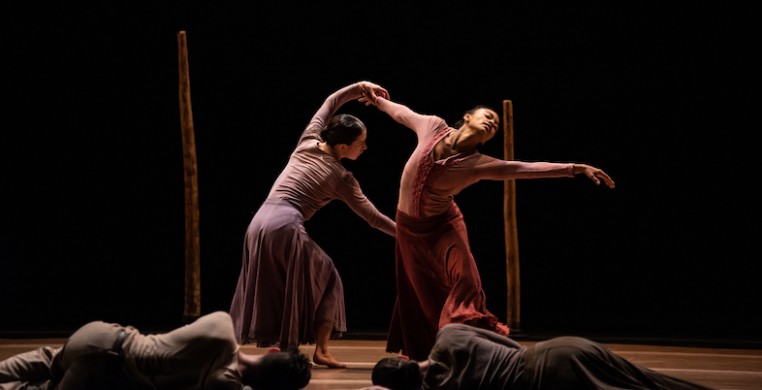On a wintery Thursday, throngs of people lined up outside the Harris Theater eager with anticipation of Hubbard Street Dance Chicago’s epic return to live performance. After a 20-month pause, “RE/TURN” marks the start of a new era for the 44-year-old dance company.
As the audience settled into their seats, masks upon every face and vaccination cards checked, Linda-Denise Fisher-Harrell stepped into the spotlight in what can only be described as the most striking black evening gown I’ve ever seen. Her palpable strength and excitement affirmed the importance of this company’s return to the stage—she is personable kind, and confident in her new role. Fisher-Harrell’s enthusiasm for the evening’s line-up only ignited the audience’s anticipation for what was to come.
Three works spanned the 110-minute show. All distinct in style, feeling and motivation. “Jardí Tancat” by Nacho Duato was the perfect slow burn into Jermaine Maurice Spivey’s world premiere, “The Seen.” And Spivey’s exploratory work paved the way for Hubbard Street’s premiere of Aszure Barton’s astounding “BUSK.” Each choreographer invited us to specific worlds, constructed for our enjoyment and thoughts.
Duato’s world was one of desert heat and historic influence. The muddy pastel costumes, warm lighting and nature-inspired sculptural backdrop evoked imagery of dry heat and sandy landscapes. The choreography, heavily influenced by Martha Graham both in dramatic flare and in technical elements, showcased somber facial expressions alongside high contractions and bell jumps. “Jardí Tancat” allowed audiences to get lost in hypnotically smooth movements, every arabesque bleeding seamlessly into the next lilting lift. The sextet of performers executed Duato’s calculated and recognizable phrase work with a striking precision, controlling everything down to the long skirts that became vital to the choreography as the piece progressed. It was the perfect ode to Hubbard as I previously knew them—technically proficient and captivatingly fluid.
If Duato’s “Jardí Tancat” was old Hubbard, the world premiere of Spivey’s “The Seen” was a representation of the new. In stark comparison to its predecessor, cold blue lights and eight ominous microphones spanned the stage in an oblong oval, giving off a ritualistic energy. Erie whispers and hauntingly dull lights immediately evoked images of horror films. As the work unfolded, I continued to guess at exactly what I was digesting. In the most rudimentary of terms, we watched 14 company members take turns speaking phrases about being seen while dancers moved amorphously in the center of the microphones surrounding them. We were watching a game.
The movement threw off an aura of improvisation, nothing ever had clear starts and stops. The dancers moved in a manner where they were feeding off one another in a way that made every step feel like the surprise of all surprises. As one dancer started counting non-linearly into the microphone, a huddle of performers ran dramatically around the stage in a controlled fashion. It looked like an exciting game and as I continued to guess the rules, smiles covered the company’s unmasked faces, creating a welcome, playful mood. “The Seen” created a world that, I want to believe, only existed in space and time for us. It was intimate and unassuming. Perfect for showcasing unorthodox aspects of what these dancers can do.
All of that being said, it was Barton’s “BUSK” that stole the evening. From start to finish I sat on the edge of my seat in eager anticipation of what was to come next. The all-black costumes of baggy pants and oversized hoodies swallowed whole the full company of dancers. Hooded, unidentifiable people piled together, alluding to at images of downtrodden peddlers, while Abdiel Figueroa Reyes’ jaw-dropping solo performed under a disco ball filled my heart with reminders that busking—in some senses—is done simply to share one’s passions with the world. “BUSK,” originally an evening length piece parsed down to fit Hubbard Street’s triple bill, is the epitome of intelligence. From strong imagery to the operatic music, to the unfalteringly unison choreography and the emotional vulnerability of the performers, Barton’s work connected with me on a level I haven’t experienced in quite some time. It deserved the standing ovation it received, and more. It was the perfect ending, and the perfect reminder to Chicago that Hubbard Street is back and in its best form.

